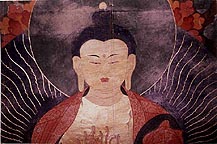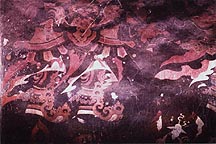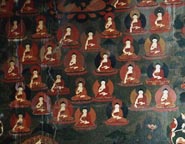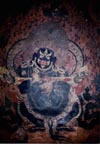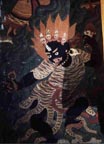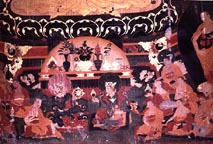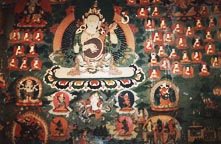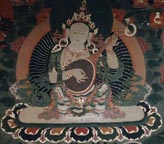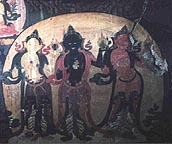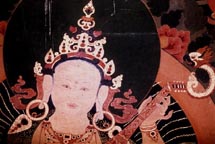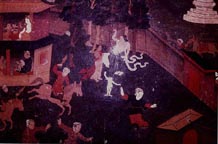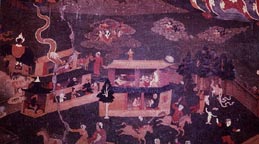Jonathan S. Bell
121, avenue d’Ivry
75013 Paris
(+33) 1.53.60.14.87
e-mail:
The murals of Dege County’s Pewar (Ch. Baiya) Monastery are truly exquisite works of art that embrace their subject matters with a mixture of vivid color and painstaking detail. From ghastly esoteric scenes of demons wearing human skins to the serenity of buddhas seated in meditation, the depictions on the walls of the temple and upper prayer room comprise a mixture of stylistic influences from within and outside Tibet. Placid Nepalese-style bodhisattvas adorned with gold and flowing scarves face characteristic Tibetan esoteric figures with multiple arms and heads, standing on lifeless bodies. Just next to this unlikely couple lies a secular scene of workers so Chinese in style that they could almost have been transplanted from a Song or Jin Dynasty Shanxi temple wall. This blend of style, coupled with the seamless transition from iconography to storytelling, results in a unique and highly syncretic body of religious art.
The purpose of this essay is to expose and identify some of the iconography and religious stories depicted on the walls of the temple. I have tried to choose some of the more exemplary large figures and commonplace narratives as an introduction to Buddhist representation within a Tibetan context. A brief description of the physical setting, that is, the temple itself, will precede the discussion of the murals.
The Temple (click for Temple Plan)
The temple, or lha-khang, (1) as it is termed in Tibetan, makes up the northernmost part of the monastery, and, as is to be expected, constitutes the largest single room in the complex, boasting over 300 square meters of space. The size, it should be remembered, reflects its historical function not only as a monument to Buddhism, which it indubitably is, but as an assembly hall for monks and lay believers alike. The structure was built and decorated in the time of the great Dege King Tenpa Tsering (1678-1738), who greatly lavished on the this monastery because it was among his last religious projects.(2) This, then, dates the murals to somewhere in the first forty years of the 18th century.
A small enclosed anteroom with irreparable murals of its own provides a buffer between the hall and the courtyard of the monastery. Entrance into the large room is achieved only after climbing a few steps and passing through this vestibule at the north end of the monastery’s inner courtyard. Two large wooden doors mark the only way in and out of the chilly home of the masterpieces to be discussed below.
The interior of the temple boasts a collection of six rows of large, impressive columns, some of which reach to the third floor of the monastery. These recently replaced supports are the first structures to greet the visitor, delineating a straight path to the altar ahead. On the outskirts of this visible expanse lie the walls, enshrouded in darkness. The eastern and western walls measure, according to my own findings, 19.6 meters in length. The walls on either side of the door stretch 8.1 m from the entrance to the respective corner. The opposing northern walls measure 8.19 m on either side of the portal leading to the back room, which boasts three large buddhas. The entire length of these walls combined, measuring 71.78 m, is adorned with rich depictions 3.37 m in height.
According to Buddhist custom, circumambulation occurs in a clockwise direction. This tradition is readily observed at any holy site in Tibet, where pilgrims and locals alike walk, prayer wheel or beads in hand, around and around a structure of some perceived religious import. Therefore, the logical progression of the subjects on the interior walls is clockwise, turning west from the entrance, north to the back of the temple, east, south, and west again back to the door. However, it is worth noting that the abbot of the monastery, Tenzeng Nyima, told me that the actual direction one follows for the reading of the murals is of little import since the tales and scenes painted on these walls are not particularly interconnected.(3) In any case, for the sake of custom and following my own findings, this paper will address the content of the murals as an interconnected temporal and physical progressive narrative.(4)
Either side of the southern and only entrance into the temple begins with six large central figures, 12 total, measuring about 1.7m in height. These figures range from guardian figures to Târâs (important female Buddhist deities in Tibetan and Nepalese illustration), and include bodhisattvas (buddhas-to-be). After these six large figures, seven buddhas of similar measurements continue around the temple to the entrance of the back room, making a total of 26 large figures in the temple, 13 on either side. The symmetry of the temple is a common attribute in such religious structures.(5) Around the 14 large Buddhas and some of the other figures are illustrative narratives, often incredibly detailed, of jataka tales, the historical Buddha’s previous lives, and avadana stories. Some scenes from his historical life, including the infamous first steps and the taking of the tonsure, are also included in these pictorial representations. In the upper register of the murals (excepting the first portions on either side of the main entrance) reign depictions of small golden buddhas in meditation, probably meant to suggest the ten thousand or thousand buddha motif common in such early mural work as that of Dunhuang.(6)
Upon entering the temple, the first painting immediately to the left (west) is devoted to mGon-po (Mahâkâla, Skt.), a dharmapâla (drag-shed or chos-skyong, Tib.), or protector of the Buddhist law. The images are covered by brightly colored silk, presumably as a testimony to the sacred importance of mGon-po and also to hide the fierce esoteric representation of the figure from the eyes of those who may misunderstand the symbolism in depictions of trampled corpses and skull cups (thod-phor, Tib.; kapâla, Skt.) filled with blood. I myself was prevented from photographing this section of the wall by one of the monks, thus attesting to the perceived sensibility of mGon-po.
This section boasts a large central figure of mGon-po in one of his most common Tibetan aspects, Gur-gyi mgon-po. In this form, also known more simply as Gur-mgon-po, he is considered to be “protector of the tent” and the patron protector of the Sa-skya-pa (or Sakya-pa) sect, thus the particular reverence paid him in Baiya Monastery, a Sakya stronghold. Though there is a dark cloud around the origins of this truly Tibeto-Mongolian form, some claim that they are to be found in nomadic traditions.(7) Regardless of the historical background of this omnipresent figure, Gur-gyi mgon-po boasts certain unalterable attributes that act as identification tags. In his left hand he holds a kapâla filled with blood and in his right, a ritual chopper (karttrka, Skt.; gri-gug, Tib.). Resting horizontally on his forearms is a magic staff (‘phrul-gyi, Tib.). As a dharmapâla, he wears the customary crown of five skulls, suggesting his fearlessness and determination to protect Buddhist law. He also bears a garland of human heads and tramples corpses, attributes inherited from his equally popular Hindu precursor, Mahâkâla.(8) Dark blue in color, he has three eyes, a forked tongue shown sticking out between two menacing fangs, and is surrounded by an aura of flames.
A host of other figures surrounds the central mGon-po, some of them other aspects of the same deity. His most prominent companions are commonplace in such devotional works and are clearly mentioned in sutra, providing a textual reference for these illustrative representations(9). It should be noted here that an enclosed shrine room dedicated to Gur-gyi mgon-po sits above the temple on the roof and also boasts murals of its own. The central figure here mirrors the one painted on the walls upstairs and the large statue held in the same room. The treatment of both is so similar that all were probably commissioned at the same time and the paintings most likely were done by the same hand or at least by the same atelier of artists. The mirrored iconography and inclusion of many of the same figures attests to the strict rules followed in the realization of such work.
This first portion of the temple wall dedicated to mGon-po is inherently Tibetan in both subject and style. The figures don their traditional representations, boasting attributes that can be seen repeated in such scenes in Tibetan thangkas and murals in collections around the world. As the central figure, Gur-gyi mGon-po dominates the composition of the wall, surrounded symmetrically by fierce esoteric figures boasting ghastly expressions and wearing an array of human, tiger, and elephant skins. This gruesome and highly unapproachable representation of certain Buddhist figures is a typical Tibetan model, though clearly inherited from earlier Indian religious art. As protectors of the Buddhist faith and the sworn enemies of ignorance, dharmapâlas like mGon-po are almost always depicted with a crown of skulls and fierce demeanor. Imbedded within their morbid and ferocious character is a symbolism that relates to the false nature of the world around us and the search for illumination of the truth.(10) Despite the inherent meaning, the monstrous design of these figures and their horrific attributes are not easily understood by the non-initiate. Thus, the colorful silk that hides the depiction, reserving it for the meditation of monks.
Continuing along the southwestern wall, the first large seated figure stands out next to the yellow and red silk covering the mGon-po just before it. Cross-legged with feet on the floor, the white female figure plays the vina, an Indian lute. She is Sarasvatî (dByangs-chan-ma, Tib.), the Hindu goddess of music, poetry, and wisdom, later adopted into Buddhism and worshipped particularly in Tibet and Japan.(11) She sits with her feet flat, yet crossed, and her knees up in the air. Draped in flowing material and heavily bejeweled, Sarasvatî boasts a
Nepalese pose, head slightly tilted to her right. Despite this Nepalese influence, the treatment of the figure is most definitely Chinese. Her fingers and face are drawn according to Chinese aesthetics and the flowing scarf on either side of her head follows a common stylized representation of fabric in motion used in painting and statuary.(12)
Her seat is in the form of an open lotus, whose petals are turned down and rimmed with gold. Multi-colored and extremely refined, this flowery throne serves not only as her pedestal and representation of understanding, but as a spatial separation between her and the host of deities and buddhas that surround her. Adorning her aureole is a layer of leafy greenery, with a lotus surmounting the halo about her head, serving the same purpose as the elaborate lotus on which she sits.
This method of expressing separation between scenes or figures of one plane from those of another is very often found in Chinese Buddhist work from much earlier times. The use of greenery and nature to separate scenes spatially and add a three-dimensional aspect to a two-dimensional medium was prominent in work at Dunhuang.(13) This stylistic tool serves as a symbol to the admirer for a planar, spatial, and or temporal division between one figure or scene and that which surrounds.
The example of Sarasvatî’s leafy adornment is in contrast to the unbroken mountainous background below and the stylized cloud motif above. In both cases, an homogeneous background is used to represent the planarexistence of the figures and their contemporaneity with each other. For example, the fierce figures beneath the representation of Sarasvatî are all set in a mountainous, forested area that presents an unbroken background for all the foreground characters. This is in contrast to the plane defined by the leafy adornment. The interpretation, then, follows that these figures exist simultaneously on the same plane.
In addition, the use of natural settings for these divine figures has a purpose in the religious teaching of the masses. Linking these ethereal beings to a very mundane and readily visible world makes the worshipper’s task of understanding their existence less of a challenge. Herein lies one of the cornerstones of Buddhist teaching: the person on the path to enlightenment rests apart from the world while remaining firmly rooted in it, just as does the omnipresent symbol in pan-Buddhist representation, the lotus.(14) Reminiscent of Tang dynasty blue-green paintings, these background mountains serve, then, both as a stylistic dimensional tool as well as a teaching aid.
Another interesting aspect of this background is the movement inherent within it, an upward progression. There is a general concentration of figures and/or architectural depictions in the lower register of these paintings that gives way to much more ethereal, airy representations in the upper portions. As has already been noted, the motif of floating meditating buddhas occurs in the upper registers, but their placid, meditative demeanor and uniformity present an empyreal contrast to the seeming unorganized mass of people, man-made structures, and greenery that colors the lower portions. One moves upward away from the earth towards truth and enlightenment, for this knowledge is not of the earth but beyond.(15)
Let us turn to the pictorial narrative present in the temple by considering the depiction of Sâkyamuni’s life on the northern portion of the east wall, halfway around the temple from the mGon-po and Sarasvatî depictions discussed above. This pictorial representation of one of the most prevalent and well-known Buddhist legends offers the material with which to consider questions of style and progression.
The story unfolds beneath the large central representation of a buddha in meditation, gilded and bearing a placid expression, one of the fourteen such central buddhas that adorn the northern half of the main temple. The thousand buddha motif continues to form a background around the central figure and a blur of architectural structures, people, and landscape narrates the life of the Buddha in the lower register. There is a hectic harmony created between all the various elements of the mural: the large recognizable central figure; the esoteric, ethereal figures and buddhas floating in space; and the pictorial narrative that anchors the rest. Here again, the discussion of upward progression is applicable and perhaps even clearer than in the example of the Sarasvatî section of the southern wall.
The tale begins in the lower left-hand corner of this section of the wall. A cloud floating above an architectural complex boasts a gilded figure and his entourage. This represents the Tusita Heaven, where the Buddha awaited his rebirth as Sâkyamuni and his life of meditation and teaching. In the Tusita heaven, he chose himself the family to which he would be born for the last time and held an audience with the gods to convince them of his decision. Parasols are held above the central Buddha as symbols of his immense spiritual power.(16)
Just beneath unfolds the conception, birth, and first years of the Buddha’s life. A wavy golden emanation to the left of the Tusita scene carries a white elephant into the side of the sleeping Mâyâ, Sâkyamuni’s mother. The legend holds that the Queen Mâyâ dreamt one night of a white elephant that entered her side. This dream, to soothsayers, represented her impregnation with a son who would become a cakravartin (lit. "one who turns the wheel", a righteous and all powerful ruler) or a Buddha, should he renounce the world.
Ten lunar months later, Mâyâ decides to leave her home of Kapilavastu to visit her parents. She parts with her sister and stops on the way in the park of Lumbini, where she grabs the branch of a tree and gives birth to the Buddha painlessly from her side. Immediately upon his birth, two nâga (serpent) kings bathe him in water poured from on high (here, only one is shown, though another nâga is nearby, seemingly part of another scene). Then, the Buddha takes seven steps in each of the cardinal directions and points to the sky, stating, "In the Heavens and on Earth, only I am the Venerable One." (17) This important event is depicted by a small golden figure with extremely long arms (one of the physical characteristics of the Buddha), the right one pointing towards the sky. It is probable that a path of lotus flowers were painted on the ground behind him, but are no longer visible, as each step of the Buddha was said to bring forth a full-blossomed lotus.
The birth scene and the more important events of his years in the palace are depicted within the enclosure of the compound walls. Although most of his early life is confined to the palace and the gardens, the scene of his birth, for example, takes place away from his kingdom of Kapilavastu. Nevertheless, this event, like all the others, is placed within the royal walls. Localizing all events of the first years of the Buddha’s life within the confines of the palace and its gardens serves both functional and symbolic purposes, a point which will be discussed further.
A number of scenes within the compound are readily recognizable, although they may not be depicted in any particular order. For example, in the upper left of this palatial portion of the mural, Mâyâ is impregnated with a white elephant. Far across to the right, she gives birth to Siddhârtha and he takes his famous first steps. Just below, the two representations of the prince at different ages almost touching, he levitates an elephant. In the central portion of the architectural structure, open windows reveal the future Buddha leading a life of utter luxury and leisure, surrounded by a harem of women. One of them plays a vînâ, others lay on cushions and the like.
This life of leisure and material wealth is carefully separated from the rest of the Buddha’s life by the palace walls. The events that lead to his discovery and realization of the pains of aging, dying, and being reborn are portrayed just outside the walls, symbolic of his passage into his life of meditation and teaching. The Buddha encounters four factors that eventually drive him to leave the life he knew within the kingdom of Kapilavastu. Old age, portrayed here by the bent over man just outside the palace, sickness, death, and a monk. The image here shows the monk prominently in the lower center, holding an alms bowl. The serenity and poise of the monk contrasted with the pains of life, death, and rebirth, appeal to Sâkyamuni and cause him to consider the plight of humanity and the method by which to address and finally resolve it.
The result is Siddhârtha’s flight from his home, accompanied by his horseman. In the same image, on the far right, the Buddha-to-be and his assistant busily build a bridge on the river Anomâ, to facilitate their voyage. The ever-gilded Sâkyamuni figure holds a tree in his hand as his assistant lays it across the river. In the upper center, the Buddha stops to take the tonsure, cutting his long hair with his own sword, an action laden with the symbolism of his determination to undertake a life of asceticism and renounce the existence he once knew. To the right, he changes his clothes with those of a hunter. Below, he takes leave of his horseman, giving him all his princely accessories to take back to Kapilasivatu, along with his horse, which, so faithful to his master, lets himself die from sadness. Just to the left, Chandaka, the horseman, and Kanthaka, Siddhârtha’s horse, leave him. The stûpa above might be a symbol of Kanthaka’s death, though that is only a suggestion.
The attractions and physical comforts of the palace are enclosed within the walls of the compound or kingdom. In contrast, the actions that lead to the mental and spiritual liberation of Siddhârtha have no boundary that encircles them. The wall here serves, as mentioned above, two very important purposes. First, it is a stylistic and functional tool that permits the visual separation of the two astoundingly different phases of the historic Buddha’s life. Second, this division serves a doctrinal and symbolic purpose of portraying the Buddha as imprisoned by the walls. Not only does he rest physically trapped, but also fettered by his own attachment to the material world and blindness to the truth that awaits him outside. To the far left of the palace structure, a dark demonic figure sits within the walls, just below the scene of Mâyâ’s impregnation. This is probably meant to represent Mâra, the embodiment of evil and temptation, who hopes to keep Sâkyamuni in Kapilasvatu so that he may never attain enlightenment.(18)
In both the palace and outside, as we have seen, there is no linear progression in time. The scenes are represented without any particular attachment to those around them, with the exception of the fact that the early part of his life is painted within the confines of the walls. There are also no other visual divisions between scenes, resulting in a pictorial narrative that requires intimate familiarity with its subject matter in order to interpret it. This indiscernible progression of events can be found in many early Buddhist works, such as the Ajanta caves in India, and comes from an early difficulty in representing literary or oral narrative in a two-dimensional depiction that is fixed in time.(19)
The story of the Buddha’s life continues to unfold all around the palace and fills the entirety of the lower register of this section of the wall. Though I have omitted many of the most important events of Sâkyamuni’s life, I do not think it necessary here to continue, since the style and treatment of the story do not greatly vary from what has already been discussed. Rather I will take the opportunity to recall some of the more important ideas already considered.
The main temple of Pewar Monastery was decorated not only as a showplace, but as a living center of practice. The large central figures represent different deities and aspects of the individual, on which one is meant to meditate. Ascetics would use such depictions to put an image to their own obstacles and achievements, so as to more easily progress. The complex iconography created for this reason is omnipresent in the Buddhist world, and particularly in that of Tibetan Buddhism.
However, these beautiful pictorial representations were not reserved for the meditation of the monks, as lay people also had access to this main hall. For this reason, the walls serve as teachers to various levels of initiates and practitioners. The images employed must be accessible to all and yet allow every audience progress in their understanding of the universe and their path towards enlightenment. These murals, then, are visual text that tell the stories, as we have seen with the life of the Buddha, and record the iconography of a syncretic world of Indian, Nepalese, Tibetan, and Chinese Buddhism.
The difficulties that arise in the production of such an endeavor are many. Capturing multiple instants in time and contemporaneously existing levels of the universe on a 2-dimensional medium poses a number of problems. The artists adapted stylistic and symbolic methods of portraying various levels of consciousness and retelling stories. Consider the greenery about the throne of Sarasvatî or the palace wall in the life of the historical Buddha, not to mention the esoteric symbolism inherent in the section devoted to mGon-po.
All of these factors make the murals of Pewar a unique piece to a large puzzle of Tibetan and Pan-Buddhist art. There is a universality in many of the images and stories evoked on these walls that are recognizable to the eyes of anyone familiar with the stories and iconography of Buddhism. However, the detail, the amount of gold, and the history of this particular monastery are unique. For this reason, a great amount of study and research need to be devoted to the masterpieces within Pewar. The walls contain a pictorial text that is priceless just in the detail and artistry employed, but also in the subject matter and in the local and regional history contained therein.
